The Monostarch Phosphate Market is estimated to be valued at USD 849.8 million in 2025 and is projected to reach USD 1479.3 million by 2035, registering a compound annual growth rate (CAGR) of 5.7% over the forecast period.
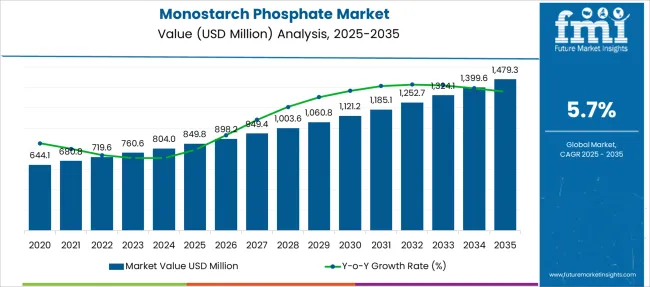
| Metric | Value |
|---|---|
| Monostarch Phosphate Market Estimated Value in (2025 E) | USD 849.8 million |
| Monostarch Phosphate Market Forecast Value in (2035 F) | USD 1479.3 million |
| Forecast CAGR (2025 to 2035) | 5.7% |
The monostarch phosphate market is experiencing steady expansion, driven by increased usage in food applications and functional ingredients across multiple industries. Evolving consumer preferences toward clean-label and functional foods have encouraged widespread adoption of modified starches for improved stability and performance.
The ability of monostarch phosphate to resist retrogradation, maintain consistent texture, and enhance freeze-thaw stability has positioned it as a critical additive in processed food and convenience products. Parallel growth in industrial applications such as textiles, paper, and pharmaceuticals is further supporting market expansion.
Stringent regulatory approvals and alignment with food safety standards have accelerated commercial adoption in established and emerging economies. Looking forward, innovation in starch processing and demand for cost-effective, high-efficiency thickeners are expected to fuel sustained growth.
The market is segmented by Type and Application and region. By Type, the market is divided into Synthetic and Natural. In terms of Application, the market is classified into Food Industry, Pharmaceutical Industry, and Other Industries. Regionally, the market is classified into North America, Latin America, Western Europe, Eastern Europe, Balkan & Baltic Countries, Russia & Belarus, Central Asia, East Asia, South Asia & Pacific, and the Middle East & Africa.
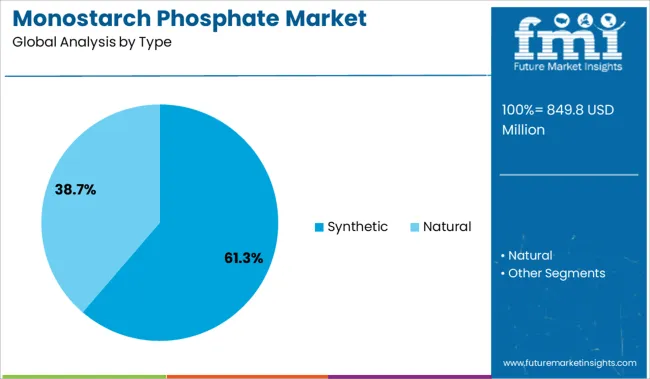
Synthetic monostarch phosphate is anticipated to account for 61.3% of the total market revenue in 2025, making it the dominant type segment. Its leadership is supported by consistent supply quality, functional stability, and ease of integration into industrial formulations.
Synthetic variants provide higher uniformity in performance characteristics such as viscosity control and resistance to shear during processing. These benefits have made them particularly preferred in high-output food manufacturing environments where standardization and efficiency are critical.
The ability to meet specific modification parameters without variability found in native starch sources has further strengthened its position. Continued innovation in chemical processing and demand for high-purity food ingredients are expected to reinforce the dominance of synthetic monostarch phosphate across sectors.
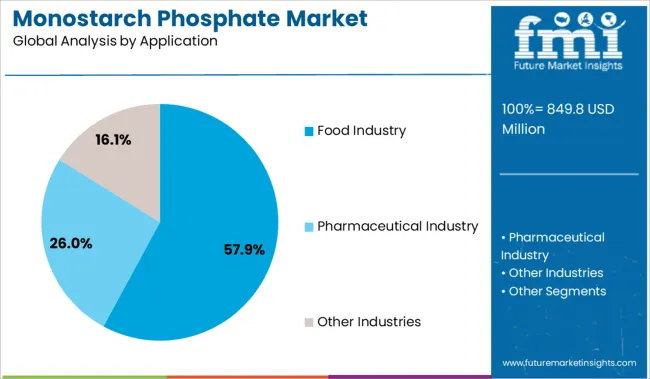
The food industry is projected to represent 57.9% of the overall monostarch phosphate market share in 2025, establishing it as the leading application segment. This stronghold is attributed to the starch’s functional role in improving shelf life, enhancing mouthfeel, and maintaining product consistency under various storage conditions.
Its compatibility with heat processing, freezing, and long-term storage has made it valuable for sauces, ready meals, dairy alternatives, and baked products. Regulatory clearances for use as a food additive and rising demand for convenience foods have further accelerated adoption.
As food manufacturers aim to deliver cleaner labels without compromising texture or appearance, monostarch phosphate remains a preferred ingredient in balancing cost, stability, and sensory quality.
The Global Market for Monostarch Phosphate increased from USD 644.1 Million to USD 678.2 Million between 2020 and 2024 with a CAGR of 6.1%.
The historical outlook for the market is positive, with strong growth expected in the coming years. The future of the Monostarch Phosphate market looks bright. Despite a slight decrease in demand over the past few years, the market is expected to grow at a steady rate in the coming years.
However, there are some concerns about the future of the market. One major concern is that new production methods could lead to a decrease in demand for Monostarch Phosphate. Another concern is that increasing environmental regulations could limit the use of Monostarch Phosphate in certain industries.
Despite these concerns, the future outlook for the Monostarch Phosphate market remains positive. Strong growth is expected in both developed and emerging markets, and new applications for Monostarch Phosphate are constantly being discovered. With continued innovation and development, the Monostarch Phosphate market is expected to thrive in the coming years.
During the forecast period, the global Monostarch Phosphate Market is anticipated to grow from USD 849.8 Million in 2025 to USD 1,252.6 Million by 2035 with a healthy CAGR of 5.7%.
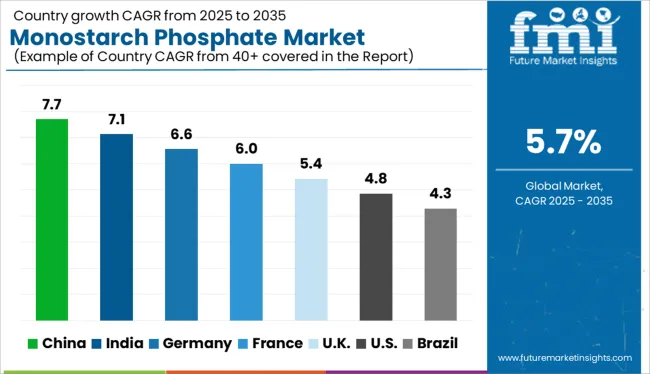
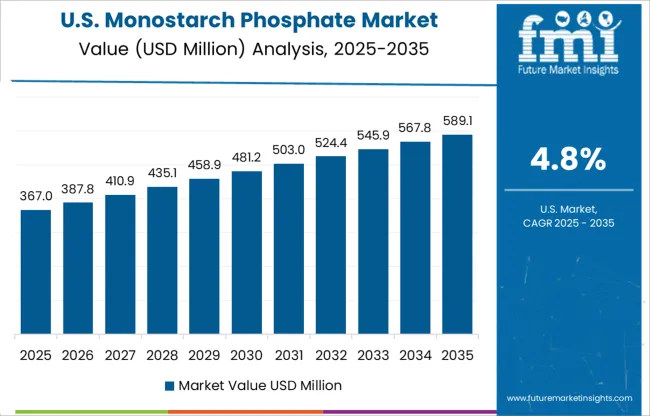
The USA accounted for 33.7% of the global market with a value of USD 849.8 Million in 2025. The major drivers of this market are the growing demand for processed food and the increasing use of Monostarch Phosphates in animal feed.
The USA Monostarch Phosphate market is highly fragmented, with a large number of small and medium-sized manufacturers. The key players in the USA Monostarch Phosphate market are Ajinomoto Co., Inc., Archer Daniels Midland Company, Cargill, Incorporated, Corn Products International, Inc., and Roquette Freres.
The India Monostarch Phosphate Market will grow at 6.0% CAGR during the forecast period of 2025 to 2035. India is the world’s largest producer and consumer of Monostarch Phosphate. Monostarch Phosphate is used as a food additive, as well as in animal feed and agriculture. In India, Monostarch Phosphate production is primarily concentrated in the states of Gujarat and Maharashtra.
The China Monostarch Phosphate Market will grow at 5.1% CAGR during the forecast period of 2025 to 2035. China's position in the global Monostarch Phosphate market is strong and growing stronger. China is the leading producer of Monostarch Phosphate due to its large population and growing demand for processed foods. Chinese manufacturers have also been able to produce Monostarch Phosphate at a lower cost than their international competitors, leading to an increase in exports.
Thermized cottage cheese, milkshakes, food concentrates, puddings, cold jelly sweets, dressings, sauces, and soups are just a few examples of the many food products that utilize this sector of modified starch. It is a white powder that is derived from starch and it is often used as a thickener or emulsifier. Monostarch Phosphate can be found in many processed foods such as baked goods, condiments, and even some baby foods.
Monostarch Phosphate is a type of starch that is used as a food additive. Natural and synthetic Monostarch Phosphate (MSP) are two different types of phosphates that are used in food processing. Natural MSP is derived from starch that has been extracted from plants such as potatoes, wheat, and corn. Synthetic MSP, on the other hand, is produced through the process of chemically treating starch with phosphoric acid or dihydrogen phosphate.

The competitive landscape is likely to heat up in the coming years as companies look to gain an edge in this rapidly growing market. Monostarch Phosphate is used as a food additive and has a wide range of applications. As such, the potential for growth in this space is significant. Companies are expected to invest heavily in research and development in order to gain a competitive advantage.
Similarly, recent trends, drivers of the market, restraints of the market, strengths, and weaknesses are analyzed and have been tracked by the FMI, which are available in the full report.
| Attribute | Details |
|---|---|
| Forecast Period | 2025 to 2035 |
| Historical Data Available for | 2020 to 2025 |
| Market Analysis | USD Million for Value and Units for Volume |
| Key Regions Covered | North America; Latin America; Western Europe; Eastern Europe; Asia Pacific Excluding Japan; Japan;Middle East and Africa(MEA) |
| Key Countries Covered | India, USA, Germany, China, United Kingdom, Japan, Denmark, Canada, Thailand, Malaysia, Mexico, Poland, Turkey, Vietnam, Indonesia, Cambodia, France, Italy, Spain, South Korea, Russia, Australia, Brazil, Argentina, South Africa |
| Key Segments Covered | Type, Application, Region |
| Key Companies Profiled | Ajinomoto Co., Inc.; Archer Daniels Midland Company; Cargill; Incorporated; Corn Products International, Inc.; and Roquette Freres. |
| Report Coverage | Drivers, Restraints, Opportunities and Threats Analysis, Market Forecast, Company Share Analysis, Market Dynamics and Challenges, Competitive Landscape, and Strategic Growth Initiatives |
| Customization & Pricing | Available upon Request |
The global monostarch phosphate market is estimated to be valued at USD 849.8 million in 2025.
The market size for the monostarch phosphate market is projected to reach USD 1,479.3 million by 2035.
The monostarch phosphate market is expected to grow at a 5.7% CAGR between 2025 and 2035.
The key product types in monostarch phosphate market are synthetic and natural.
In terms of application, food industry segment to command 57.9% share in the monostarch phosphate market in 2025.






Full Research Suite comprises of:
Market outlook & trends analysis
Interviews & case studies
Strategic recommendations
Vendor profiles & capabilities analysis
5-year forecasts
8 regions and 60+ country-level data splits
Market segment data splits
12 months of continuous data updates
DELIVERED AS:
PDF EXCEL ONLINE
Phosphated Ester Market Size and Share Forecast Outlook 2025 to 2035
Phosphate Salts Market Size and Share Forecast Outlook 2025 to 2035
Phosphate Fertilizer Market Size, Growth, and Forecast 2025 to 2035
Phosphate Conversion Coatings Market 2025 to 2035
Phosphate Market Growth - Trends & Forecast 2024 to 2034
Phosphate Esters Market
Phosphated Distarch Phosphate Market
Diphosphates Market Analysis - Size and Share Forecast Outlook 2025 to 2035
Polyphosphate Market Food-Grade, Feed Grade, Cosmetic Grade and Other Grades through 2035
Iron Phosphate Market Size and Share Forecast Outlook 2025 to 2035
Hyperphosphatemia Market Size and Share Forecast Outlook 2025 to 2035
Feed Phosphate Market Analysis by Product, Livestock, and Region through 2035
Organophosphate Insecticides Market Size and Share Forecast Outlook 2025 to 2035
Organophosphate Pesticides Market
Sodium Phosphate Market Growth & Demand Forecast 2025 to 2035
Ferric Phosphate Market
Calcium Phosphate Market Size and Share Forecast Outlook 2025 to 2035
Distarch Phosphate Market Size and Share Forecast Outlook 2025 to 2035
Ammonium Phosphate Market Trends & Analysis 2019-2029
Industrial Phosphates Market Size and Share Forecast Outlook 2025 to 2035

Thank you!
You will receive an email from our Business Development Manager. Please be sure to check your SPAM/JUNK folder too.
Chat With
MaRIA